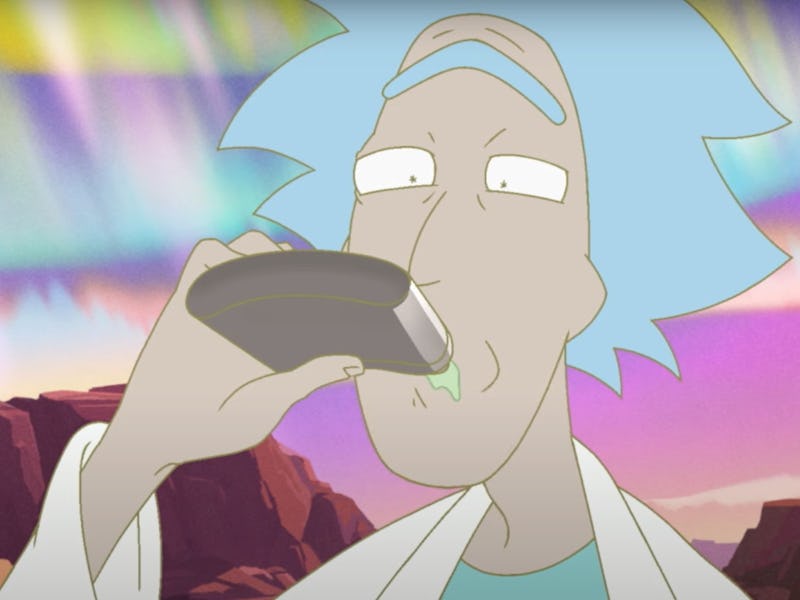Rick and Morty: The Anime Is So Much More Than a Japanese Spinoff
But don’t worry, it’s still canon.

The creators of Rick and Morty have a love-hate relationship with the show’s own canon. Sure, lore-heavy episodes that moved the overarching story of characters like “Evil Morty” and “Rick Prime” forward helped create a massive and devoted (if sometimes toxic) fan base, but Dan Harmon and his team seem happiest when they can tell simple, episodic stories that don’t interact with bigger canon questions. So it may come as a surprise that the show’s first official spinoff, Rick and Morty: The Anime, is canon to the franchise — despite featuring a new cast and a unique visual style.
“In a world where there are infinite multiverses, one of those is going to be an anime multiverse,” Jason DeMarco, who heads up action and anime for Adult Swim, told Inverse during an interview at San Diego Comic-Con. “So Rick and Morty: The Anime is automatically canon because within their multiverse, almost anything could be canon.”
Created by Takashi Sano, Rick and Morty: The Anime might be canon, but it’s also so distinct from Rick and Morty that calling it a spinoff might be too much of a stretch.
“This isn't a spinoff, this is [Sano’s] reinterpretation of the characters and themes from the original,” DeMarco said. “He had the freedom to interpret them how he wanted within the framework that was already laid down by the show.”
The series is an extension of four previous anime-style shorts released years earlier that saw the duo transported to feudal Japan and fighting off giant monsters. But longer episodes give the anime more time to breathe, allowing for a notable change of tone that’s not just Rick and Morty in samurai armor.
Rick and Morty: The Anime is much more of an anime than it is a take on Rick and Morty. Gone are Rick’s belches and the joke-a-minute pace. Instead, the dialogue is slower, deliberate, and deadly serious. When Morty explores a VR game in the first episode, that subplot feels more like a character study than comic relief. And when the Rick Prime concept from the original show is revisited, the stakes feel incredibly more perilous. Even the return of the famously dead antagonist Tammy Guterman makes her feel like an all-time villain on par with Darth Vader.
While parts of Rick and Morty: The Anime look familiar, it’s still a new interpretation.
The series is, thematically, very similar to Rick and Morty itself, with lots of space travel, multiversal hijinks, and creative cultural references. But now, those references aren’t to Western pop culture, but to classic anime tropes drawing on the isekai nature of Rick and Morty’s original premise of thrusting an ordinary boy into a strange new world. And don’t worry: it’s all Dan Harmon-approved.
“We would send it to Dan and Scott Marder and the team and have them look it over, but they almost never gave us any tweaks or changes,” DeMarco said. “They'd just be like, ‘Yeah, cool.’ So they were excellent collaborators, as far as I'm concerned, because they left us alone.”
Rick and Morty: The Anime looks completely unlike the round curves and bold lines of Rick and Morty, but the aesthetic is also very different than many American fans’ generic idea of “anime.” In designing the characters, creator Takashi Sano didn’t start with black outlines like most anime series. Instead, he used a brownish color to make the colors look more vibrant without a hard outline. It’s a minor difference, but it makes the entire show feel distinct from both its source material and its visual inspiration.
The other big difference in the series is the opening theme. Gone is the synth-y theremin of Rick and Morty, replaced with “Love is Entropy,” a two-minute-long song that bounces from genre to genre along with the opening sequence itself. We see aliens, Morty at home, a brash metal interlude shown with scratchy drawings, and a sweeping romantic moment complete with flower petals floating in the wind.
“Rick and Morty, to [Takashi Sano], it's a chaotic mix of something wonderful,” Executive Producer Joseph Chou told Inverse. “So he just wanted to get all kinds of voices, all kinds of music, metal, and everything all mixed in to convey the sense of Rick and Morty, how all these different influences convulse together to create this wonderful thing.”
The opening isn’t the only change to how the series sounds. Rick and Morty: The Anime will air on Adult Swim dubbed in English, as opposed to in the original Japanese with the Japanese voice actors of Rick and Morty. But that’s not some big statement in the never-ending subs vs. dubs debate — it was an issue of global appeal.
“I prefer the subtitled version.”
“Originally, much like the shorts, we were just producing this in Japanese,” DeMarco said. “However, pretty early on it became clear that this is going to roll out internationally, wherever there’s Adult Swim. And there are other countries where actually having an English dub actually helps the show get seen way more than just if you were releasing it in Japanese.”
But the English dub doesn’t bring back the original Rick and Morty cast: it’s an entirely new performance. That unfamiliarity, combined with the unique ineffable quality of the show under Takashi Sono’s guidance, means it doesn’t matter how you watch it — it still feels like anime.
“We all were shocked at how well it worked in English. If you have a preference for one or the other, watch it that way,” DeMarco said. “I prefer the subtitled version, but that's just me.”